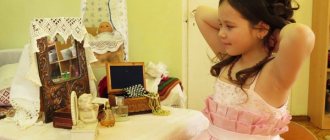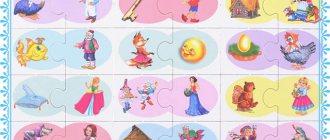GCD in the first junior group of kindergarten. On a visit to the kolobok. Theatrical activities
Development of aesthetic abilities
and the emotional sphere of a child’s personality through theatrical art. Summary of an open lesson on the topic “ On a visit to Kolobok” In the 1st junior group “Kolobok” MDOU kindergarten No. 3 “Rainbow” p. Donskoy Trunovsky district. Teacher Shunkova T.V. May 20,
2003
Tasks
1 subgroup
2 subgroup
Literary material. Notes.
Show children
how to use substitute objects.
Exercise children in rolling caps and making Christmas trees out of 3 parts. Repeat primary colors.
Develop the emotional sphere of the personality. Encourage to depict different emotional states using gestures and facial expressions on behalf of the animal character.
Develop dexterity and the ability to maintain balance.
Learn to regulate the strength of your voice.
Develop motor coordination activity of the hand.
Activation of mental activity.
Display of grandfather and woman figures on flannelgraph. Start a fairy tale.
Display of grandfather and grandmother dolls (coming out of the sensory house).
Grandmother gives Kolobok a book so that he won’t be bored sitting on the window.
In front of the children, make a bun out of a ball. (Tie a scarf with arms and legs, glue the nose and eyes with tape, attach an elastic band to guide the doll.)
Exercise. Practical activities
.
Make Christmas trees from multi-colored caps.
(It’s okay that the Christmas trees are different colors - the forest will be fabulous). As the kolobok moves through the forest, children name the color of the Christmas trees. Game - imitation: Bunny is jumping, Bunny is afraid.
Tell poems with your hands
:
“Once upon a time there were bunnies at the edge of the forest. Once upon a time there were bunnies in a small hut...
Musical pause.
“Dance bunny.” (Insert the text “Bunny smile)
Game - imitation
“The bun is rolling, and suddenly wolves come out of the hole and scare the bun.” (Children crawl under the arc, make scary eyes, change their gait...)
Physical pause
.
Non-standard equipment: 1. “Walk on the pebbles” (Traces made of buttons sewn onto the path) 2. “Walk along the bridge” (Tubes made of hoops connected by a cord)
Physical pause
.
Non-standard equipment: 1. “Walk on the pebbles.” 2. “Walk over the bumps” (Foam disks of different sizes, covered with colored oilcloth and connected by a common cord) 3. “Walk along the bridge.”
Kolobok hid! Have to search. We call loudly
: “Kolobok come to us!” We found a bear.
Tell poems with your hands
: “It’s like snow on a hill, snow...”
Exercise
: choose the softest pillow.
Name the “filling” of the pillows.
We call Kolobok quiet
voice.
Kolobok met a fox. - “Show me how a fox walks. He wants to eat Kolobok.”
Exercise
: make flowers for the fox. (Insert petals into double circles.)
Give the fox a Mysterious Book.
Guess the illustrations.
Surprise
. Kolobok returned home. Grandfather and woman take treats for children out of the house - koloboks.
Everyone, just a minute! I want to start a fairy tale. the name of this fairy tale . Once upon a time there lived a grandfather and a woman In a clearing by the river, And the grandfather and woman loved
On sour cream...(koloboks)
Once upon a time there was a Kolobok, A Kolobok - a ruddy side. Didn't lie on the window, rolled along the path
.
Mystery. Long ears, Fast legs. Jumps deftly, loves carrots.
After the dance, we seat the children behind the arc “mink”: We are little bunnies, We are little bunnies - runaways.. We live here
Under the Christmas tree And hide from the wolf.
We remove
the bun.
Hiding the bear: for younger ones - under a layer of batting. For older people - under the Christmas tree.
Sensory pads
stuffed with natural materials: pine cones, cotton wool, sticks, pebbles, nut shells...
Construct based on the theatrical game "Kolobok"
Construct
organizing joint educational activities
by PM.
02 Organization of various types of activities and communication of children
Date:
5.03.2019
DOO:
Age group:
average
Educator:
Methodist:
Educational area:
social – communicative; artistic and aesthetic
Kind of activity:
Theatrical activities
Subject:
Theatrical game "Kolobok"
Forms of organization:
group
Planned result:
- Children are able to show interest in theatrical play by acquiring more complex gaming skills (the ability to perceive an artistic image, monitor the development and interaction of characters).
- Children are able to work in a group, establish partnerships in the process of joint activities;
- Children are able to acquire more complex gaming skills (the ability to perceive an artistic image, monitor the development and interaction of characters);
- Children are able to analyze the expressiveness of play images and the work of their peers;
Target:
developing children's skills for joint play activities.
Educational tasks
:
- cultivate the ability to negotiate in the process of distributing roles, in the process of planning the playing space;
- cultivate a friendly attitude towards peers, self-confidence, positive self-esteem
Developmental tasks:
- To develop children's interest in theatrical play by acquiring more complex gaming skills (the ability to perceive an artistic image, monitor the development and interaction of characters).
- Develop the ability to work in a group, establish partnerships in the process of joint activities;
Training tasks:
- Teach children to perform simple performances based on familiar literary works; use known expressive means (intonation, facial expressions, gesture) to embody the image.
Principles of preschool education (FSES):
full-fledged experience by the child of all stages of childhood (infancy, early and preschool age), enrichment (amplification) of child development; building educational activities based on the individual characteristics of each child, in which the child himself becomes active in choosing the content of his education, becomes a subject of education (hereinafter - individualization of preschool education; the formation of cognitive interests and cognitive actions of the child in various types of activities; age adequacy of preschool education (compliance conditions, requirements, methods, age and developmental characteristics);
Principles of education:
creating a positive emotional uplift, developing a personal style of interaction with peers and teachers, education through interaction.
Game equipment:
— Coloring pages; sheets of paper, dolls with fairy tale characters
Game roles:
old woman, old man, bun, hare, fox, wolf, bear, spectators
1. Motivation for joint activities
Task:
- Gather children's attention and motivate them for upcoming activities
Conversation
Explanation
Problem situation
Emotional stimulation
The teacher creates a game situation, encourages children to set a game goal
Guys, look what I found under the door of our group! What do you think this is? (package)
That's right guys, this is a package. Would you like to know what's inside this package? (Yes)
Guys, look at the parcel, it says something, let's read it? (Let's)
Guys, this is a riddle, do you want to solve it? (Yes)
He left his grandfather
And he left his grandmother. Only, unfortunately, in the forest I met a cunning Fox... (Kolobok)
Hurray, we solved this riddle together!
Children approach the teacher, enter into dialogue, and respond emotionally to the problematic situation.
Children respond emotionally to a problematic situation, with interest and curiosity.
2. Joint game planning.
Task:
- To develop and show children's interest in theatrical play by acquiring more complex gaming skills (the ability to perceive an artistic image, monitor the development and interaction of characters).
Conversation
Show
The teacher involves children in joint activities, organizes discussion
You are ready? Are we opening the parcel? (Yes)
Guys, what is this? (poster)
That’s right, this is a poster and look, there are also toys that can be put on the hand and fingers.
What do you think the poster is for?
That's right, she warns us that a performance will take place soon, what performance do you think is shown on the poster? - Well, of course, “Kolobok”
Oh, do you want to watch it today? (yes) How about becoming the heroes of this fairy tale yourself? (Yes)
Guys, where are the performances shown? (in the theatre)
That's right, in the theater, but who can we show our performance to? Who will be our viewers? Let's think together.
It’s a good idea, we can show our performance right in our group.
Guys, do you remember the fairy tale well? (Yes). Who did the bun meet first? Oh, today our theater will be unusual, why do you think?
The teacher listens to the children's answers
Of course, we have toys that you can control and talk to.
And now we need to distribute the roles of who will play which fairy tale hero in our performance. Do you remember all the heroes of the fairy tale? Let's list them together:
-hare
-wolf
-fox
-bear
How will we distribute roles? -Can we hold a draw? (yes) I have cards just for you, whoever draws which picture will play that hero. Do you agree? (yes), guys, can I be the narrator? (yes), let's discuss who got what roles, who will behave in this role, and who will convey emotions and facial expressions.
And for the audience we have a workshop where they can make postcards to our artists and present them after the performance.
Masha, what is the hare like in the fairy tale? Show us how our hare can jump.
Marusya, what about the fox? Transfer all the fox’s cunning to a toy, but how will the fox talk to the kolobok? Good girl!
Gleb, how does a bear behave in a fairy tale? Can you transfer this image of a bear to a toy? Show us please. Well done! How will he talk?
Miron, how does a wolf behave in a fairy tale? Show us the image of a wolf using a toy, how will it speak?
Vika, show us what kind of bun we have with the help of a toy, and how will the bun talk?
Well done guys, we've rehearsed everything, now it's time to show the fairy tale!
The teacher rehearses a fairy tale together with the children.
Children participate in dialogue with the teacher, show activity and curiosity
Children show
interest in theatrical play through the acquisition of more complex gaming skills (the ability to perceive an artistic image, monitor the development and interaction of characters).
3.Implementation of the game concept
Tasks:
- Develop the ability to work in a group, establish partnerships in the process of joint activities;
Artistic word.
Emotional stimulation
The teacher organizes the game process. Teacher as Narrator
:
Hello dear viewers, are you all comfortable in your seats?
Today we will show you one interesting fairy tale. It’s called “Kolobok” and so,
“Once upon a time there lived an old man and an old woman. So the old man says to the old woman: “Come on, old woman, scratch the box, mark the bottom, see if you can scrape some flour into a bun.” The old woman took the wing, scraped it along the box, swept it along the bottom and scraped up two handfuls of flour. She kneaded the flour with sour cream, made a bun, fried it in oil and put it on the window to cool. The bun lay there, lay there, took it, and then rolled - from the window to the bench, from the bench to the floor, on the floor to the door, jumped over the threshold - and into the entryway, from the entryway to the porch, from the porch to the yard, from the yard through the gate, further and further” The teacher plays with the children, provides indirect guidance, corrects the children’s play actions, and emotionally stimulates play actions.
Children are active and interact during play activities.
-Children are able to work in a group, establish partnerships in the process of joint activities;
4.Analysis of the achievement of the game task, the achievement of children in the implementation of the game plan
Tasks :
- The ability to analyze the expressiveness of game images and the work of their peers.
Conversation
Promotion
Analysis
The teacher encourages children to analyze the achievement of the game task
Did you guys like our performance? What do you think our fairy tale teaches? The teacher listens to the children's answers
That's right guys.
She teaches you to be careful with strangers and not to go far from your parents alone.
Which artists did you like? And why?
The teacher listens to the children's answers
Children analyze the achievement of a goal,
evaluate the performance of artists
-Children are able to analyze the expressiveness of play images and the work of their peers.
5. Openness to orientation towards children’s independent activities
Tasks:
- Reinforce the acquired knowledge in children.
Conversation
The teacher encourages the use of games in independent activities.
Guys, at the end of our fairy tale, the fox ate the bun, and now grandparents are crying and sad, how do you think we can help them? (draw a bun
, blind)
The teacher listens to the children's answers.
Of course, well done! I suggest you go to the table and draw a kolobok for your grandparents.
Children participate in the conversation.
-Desire to use the game in independent activities
Application
Once upon a time there lived an old man and an old woman. So the old man says to the old woman: “Come on, old woman, scratch the box, mark the bottom, see if you can scrape some flour into a bun.” The old woman took the wing, scraped it along the box, swept it along the bottom and scraped up two handfuls of flour. She kneaded the flour with sour cream, made a bun, fried it in oil and put it on the window to cool. The bun lay there, lay there, took it, and then rolled - from the window to the bench, from the bench to the floor, on the floor to the door, jumped over the threshold - and into the entryway, from the entryway to the porch, from the porch to the yard, from the yard through the gate, further and further. Kolobok is rolling along the road, and the Hare meets him: “Kolobok, Kolobok, I’ll eat you!” - Don’t eat me, Hare, I’ll sing you a song:
I am Kolobok, Kolobok, I am scraping the box, sweeping the bottom of the barrel, Meshon on sour cream, Yes, pryazhon in butter, Stuzhon on the window. I left my grandfather, I left my grandmother, I’ll leave you, the hare, even more so!
And he rolled down the road - only the Hare saw him! Kolobok rolls, the Wolf meets him: - Kolobok, Kolobok, I will eat you! - Don’t eat me, Gray Wolf, I’ll sing you a song:
I am Kolobok, Kolobok, I am scraping the box, sweeping the bottom of the barrel, Meshon on sour cream, Yes, pryazhon in butter, Stuzhon on the window. I left my grandfather, I left my grandmother, I left the hare, I’ll leave you, wolf, even more so!
And he rolled down the road - only the Wolf saw him! Kolobok rolls, the Bear meets him: - Kolobok, Kolobok, I will eat you! - Where can you, clubfoot, eat me!
I am Kolobok, Kolobok, I am scraping the box, sweeping the bottom of the barrel, Meshon on sour cream, Yes, pryazhon in butter, Stuzhon on the window. I left my grandfather, I left my grandmother, I left the hare, I left the wolf, I’ll leave you, bear, even more so!
And he rolled again - only the Bear saw him! Kolobok is rolling, the Fox meets him: - Kolobok, Kolobok, where are you rolling? - I'm rolling along the path. - Kolobok, Kolobok, sing me a song! Kolobok sang:
I am Kolobok, Kolobok, I am scraping the box, sweeping the bottom of the barrel, Meshon on sour cream, Yes, pryazhon in butter, Stuzhon on the window. I left my grandfather, I left my grandmother, I left the hare, I left the wolf, I left the bear, It’s easy to leave you, fox!
And Lisa says: “Oh, the song is good, but I can’t hear well.” Kolobok, Kolobok, sit on my toe and sing one more time, louder. Kolobok jumped up on the Fox's nose and sang the same song louder. And the Fox told him again: “Kolobok, Kolobok, sit on my tongue and sing for the last time.” The bun jumped on the Fox's tongue, and the Fox made a noise! - and ate it.





